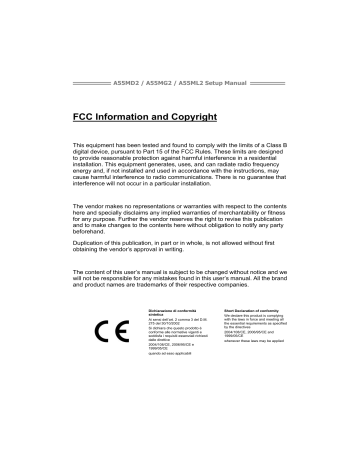- Computers & electronics
- Computer components
- System components
- Motherboards
- Biostar
- A55MD2
- Owner's manual
advertisement

Motherboard Manual
Operating System
Supports Windows Vista , Windows 7 and Windows 8.
Raid Arrays
RAID supports the following types of RAID arrays:
RAID 0:
RAID 0 defines a disk striping scheme that improves disk read and write times for many applications.
RAID 1:
RAID 1 defines techniques for mirroring data.
RAID 10:
RAID 10 combines the techniques used in RAID 0 and RAID 1.
RAID Definitions
RAID 0:
The controller “stripes” data across multiple drives in a RAID 0 array system. It breaks up a large file into smaller blocks and performs disk reads and writes across multiple drives in parallel. The size of each block is determined by the stripe size parameter, which you set during the creation of the RAID set based on the system environment. This technique reduces overall disk access time and offers high bandwidth.
Features and Benefits
Drives:
Minimum 2, and maximum is up to 6 or 8. Depending on the platform.
Uses:
Intended for non-critical data requiring high data throughput, or any environment that does not require fault tolerance.
Benefits:
provides increased data throughput, especially for large files. No capacity loss penalty for parity.
Drawbacks:
Does not deliver any fault tolerance. If any drive in the array fails, all data is lost.
Fault Tolerance:
No.
Total Capacity:
(Minimal. HDD Capacity) x (Connected HDDs Amount)
26
Block 1
Block 3
Block 5
Block 2
Block 4
Block 6
A55MD2 / A55MG2 / A55ML2
RAID 1:
Every read and write is actually carried out in parallel across 2 disk drives in a
RAID 1 array system. The mirrored (backup) copy of the data can reside on the same disk or on a second redundant drive in the array. RAID 1 provides a hot-standby copy of data if the active volume or drive is corrupted or becomes unavailable because of a hardware failure.
RAID techniques can be applied for high-availability solutions, or as a form of automatic backup that eliminates tedious manual backups to more expensive and less reliable media.
Features and Benefits
Drives:
Minimum 2, and maximum is 2.
Uses:
RAID 1 is ideal for small databases or any other application that requires fault tolerance and minimal capacity.
Benefits:
Provides 100% data redundancy. Should one drive fail, the controller switches to the other drive.
Drawbacks:
Requires 2 drives for the storage space of one drive.
Performance is impaired during drive rebuilds.
Fault Tolerance:
Yes.
Block 1
Block 2
Block 3
Block 1
Block 2
Block 3
27
Motherboard Manual
RAID 10:
RAID 1 drives can be stripped using RAID 0 techniques.Resulting in a RAID 10 solution for improved resiliency, performance and rebuild performance.
Features and Benefits
Drives:
Minimum 4, and maximum is 6 or 8, depending on the platform.
Benefits:
Optimizes for both fault tolerance and performance, allowing for automatic redundancy. May be simultaneously used with other RAID levels in an array, and allows for spare disks.
Drawbacks:
Requires twice the available disk space for data redundancy, the same as RAID level 1.
Fault Tolerance:
Yes.
Block 1
Block 3
Block 5
Block 1
Block 3
Block 5
Block 2
Block 4
Block 6
Block 2
Block 4
Block 6
28
advertisement
Related manuals
advertisement
Table of contents
- 3 Chapter 1: Introduction
- 3 Before You Start
- 3 Package Checklist
- 4 Motherboard Specifications
- 5 Rear Panel Connectors
- 6 Motherboard Layout
- 7 Chapter 2: Hardware Installation
- 7 Install Central Processing Unit (CPU)
- 8 Install a Heatsink
- 9 Connect Cooling Fans
- 10 Install System Memory
- 12 Expansion Slots
- 13 Jumper Setting
- 14 Headers & Connectors
- 18 Chapter 3: UEFI BIOS & Software
- 18 UEFI BIOS Setup
- 18 BIOS Update
- 23 Software
- 25 Chapter 4: Useful Help
- 25 Driver Installation
- 26 AMI BIOS Beep Code
- 26 Troubleshooting
- 28 RAID Functions
- 31 AMD DUAL Graphics Technology
- 34 Appendix: Specifications In Other Languages
- 34 Arabic
- 36 French
- 38 German
- 40 Italian
- 42 Japanese
- 44 Polish
- 46 Portuguese
- 48 Russian
- 50 Spanish